

The flower that thrives on neglect
COLUMBIA, Mo. – Few garden flowers give more and ask for less than daylily.
Cover crop residue can complicate nitrogen management in corn
COLUMBIA, Mo. – Farmers who rely on surface-applied nitrogen may have difficulty if they apply to fields with high surface residue, says University of Missouri Extension nutrient management specialist John Lory.This is especially true for UAN solution, Lory says. Residue can temporarily tie up nitrogen fertilizer because it is taken up by microorganisms decomposing the residue.“This is particularly a problem with liquid nitrogen…
It's time to plant summer's noon ambrosia—sweet corn
COLUMBIA, Mo.
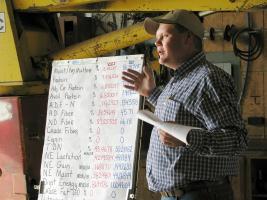
Testing tells alfalfa's worth
ASH GROVE, Mo. – “Cows and horses think alfalfa looks like candy, smells like candy and tastes like candy,” says University of Missouri Extension livestock specialist Andrew McCorkill.However, alfalfa’s proof is in the pudding. Not all hay that looks good is good hay. Not all good hay looks good. The only way to know is by testing samples to determine the nutritional value.

Rare fish, found only in Perry County, sheds light on improved water quality
PERRYVILLE, Mo. – A rare cave-dwelling fish is shedding new light on how farmers are improving water quality through cover crops and nutrient management.University of Missouri Extension and the Missouri Department of Conservation (MDC) say new nests of grotto sculpin are growing in caves in southeastern Missouri.
AgrAbility raises awareness of medicines' side effects
COLUMBIA, Mo. – All medicine has side effects.Even minor side effects can be deadly for farmers, says Kelly Cochran of the Missouri AgrAbility Project’s Pharm to Farm program.The statewide outreach program helps farmers identify medical risks through their local pharmacist. In many rural Missouri areas, pharmacists fill health care gaps. They are the first line of defense in farm health and safety.
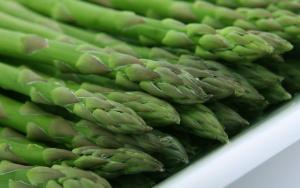
Asparagus, the food of emperors, reigns supreme
COLUMBIA, Mo. – Nothing sings spring more than asparagus.
Cleansing rain helps wheat after flood
COLUMBIA, Mo.—Wheat flooded before harvest brings questions from affected farmers. What do they do now?University of Missouri Extension field crops specialists said, “Wait and see.” During a weekly teleconference, field staff answered questions from farmers.Dirty or even mud-caked wheat could benefit from more rain. The forecast for many parts the state includes rain.
Let flood-damaged homes dry thoroughly before installing new coverings
Related video: How to use a moisture meter, youtube.com/watch?v=na4_yVBLIjYPERRYVILLE, Mo. – Before replacing drywall and floor coverings in your flooded home, make sure building materials have had enough time to dry out, cautions a University of Missouri Extension community emergency management specialist.

Warm, wet weather can trigger mold growth
COLUMBIA, Mo. – Moisture and rising temperatures can turn parts of your home into ideal sites for mold growth, said a University of Missouri Extension housing and environmental design specialist.Houses damaged by storms and flooding are especially vulnerable, but mold can strike any home. “Mold is everywhere,” said Michael Goldschmidt.
Protect yourself from contractor fraud
COLUMBIA, Mo. – When storms, floods and other disasters leave damaged homes in their path, local contractors often get more business than they can handle. In many cases, out-of-town contractors will arrive in force to pick up the slack. Think twice and exercise caution before accepting the services of an out-of-town contractor, advises a University of Missouri Extension family financial education specialist.
Reducing flood damage to home and property
TRENTON, Mo.– University of Missouri Extension has prepared a checklist of measures people can take to reduce the impact of floodwater on their homes. __KNOW YOUR FLOOD RISK: Call your local emergency management office for information about flooding. Pay attention media reports monitoring the situation and the estimated date/time of arrival.
April rains affect May forages; alfalfa turns yellow in wet fields
COLUMBIA, Mo. – Alfalfa fields fading from green to yellow may mean too much water. Farmers see the change after record-setting rains.Waterlogged soil kills nitrogen-fixing bacteria on roots, says Craig Roberts. The University of Missouri Extension specialist alerted area specialists of the problems. There are fixes.
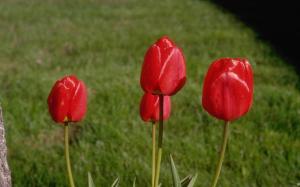
After-bloom bulb care means bigger flowers next year
COLUMBIA, Mo. – The ukulele-playing Tiny Tim may have strummed it best. “Tiptoe Through the Tulips” is good advice for gardeners.
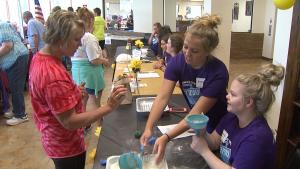
Mizzou Alternative Breaks program emphasizes service
OWENSVILLE, Mo. – It’s a beautiful Saturday morning in spring, perfect for outdoor fun and relaxation. But about a dozen University of Missouri students are devoting the weekend to service. They started the day working at a health fair at the Gasconade Manor nursing home. In the afternoon they’ll go to the nearby Head Start center to do some cleaning, sweep the playground and set up a new picnic table.

Perryville tornado shows value of mapping systems, planning
PERRYVILLE, Mo. – New technology and old-school knowledge mixed in the aftermath of the tornado that struck Perry County Feb. 28.The EF4 tornado ripped a 14-mile-long path through Perryville, population 8,225, and rural Perry County in southeastern Missouri. One motorist died when the tornado lifted a parked car and slammed it into the path of traffic on Interstate 55. The tornado stripped more than 50 homes and farm buildings to their…
![Beets are nutritious and easy to grow.Photo by Evan Amos [CC BY-SA 2.0] via Wikimedia Commons](/sites/default/files/styles/flexslider_full_no_crop_300x200/public/wysiwyg/Extensiondata/NewsAdmin/Photos/Beets-Bundle.jpg?itok=MitTW0ox)
It's hard to beat beets for nutrition
COLUMBIA, Mo. – Love them or hate them, the beet’s nutritional value is as intense as its striking purple color.
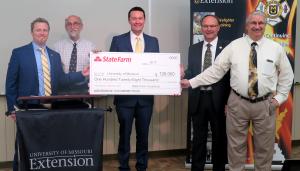
State Farm gift supports MU Extension programs
COLUMBIA, Mo. – A State Farm Insurance Co. donation of $128,000 presented April 13 includes support for several University of Missouri Extension programs:
![Sweet autumn clematis.Photo by Katrina Wiese [CC BY-SA 2.0] via Wikimedia Commons](/sites/default/files/styles/flexslider_full_no_crop_300x200/public/wysiwyg/Extensiondata/NewsAdmin/Photos/Clematis_terniflora.jpg?itok=C8SIeW0E)
Clematis, 'Queen of the Vines,' climbs in popularity
COLUMBIA, Mo. – Few flowering ornamentals are as exquisite as the “Queen of the Vines”—clematis.

Don 'Mr. Soybean' Heil inducted into Mo. Soybean Hall of Fame
NORBORNE, Mo. – The Missouri Soybean Hall of Fame inducted its first member, a Norborne farmer known as “Mr. Soybean.”The late Donald W. Heil, a lifelong farmer in the Missouri River bottoms of Carroll County, earned honors as an international promoter of soybean, said Bill Wiebold, University of Missouri Extension soybean specialist.

Missouri’s state tree shines in Ozarks
COLUMBIA, Mo. – The dogwood tree’s stunning beauty echoes from the Ozark hillsides in April.The spectacular show of color bears witness to why the dogwood is worthy of being Missouri’s state tree, said University of Missouri Extension horticulturist David Trinklein.
Prepare for disease outbreaks in livestock operations with written plan
COLUMBIA, Mo. – A written plan to respond to disease outbreaks for your livestock operation is like insurance. You hope you never need it. You may never need it. But if there is an outbreak, the economic survival of your livestock operation might depend on having that plan.Planning and prevention are the best insurance against an outbreak, says University of Missouri Extension economist Ray Massey.
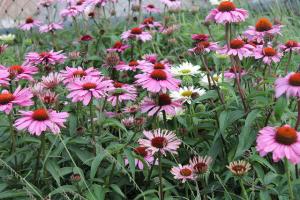
Nativars offer the best of both worlds
COLUMBIA, Mo. – Nativars, superhero plants that possess the virtues of native plants but in a more attractive package, make good choices for landscaped areas.

Master Gardener's Big Italian tomato goes national
MEXICO, Mo. – A national tomato growers supply company honors a Missouri Advanced Master Gardener this spring by selling tomato seeds she saved for decades.On the cover of its 2017 catalog, the Tomato Growers Supply Co. features “Mrs. Maxwell’s Big Italian,” an heirloom beefsteak tomato prized for its flavor. The dark pink tomato is the result of seed-saving by the late Sally Maxwell of Mexico, Mo.
MU part of $6.6 million research project on cover crops
COLUMBIA, Mo. – University of Missouri is part of a $6.6 million research initiative to promote soil health through cover crops.Rob Myers, MU adjunct associate professor and north-central regional director of extension programs for the USDA’s Sustainable Agriculture Research Education program, was the lead organizer in obtaining funding for the multistate project.
